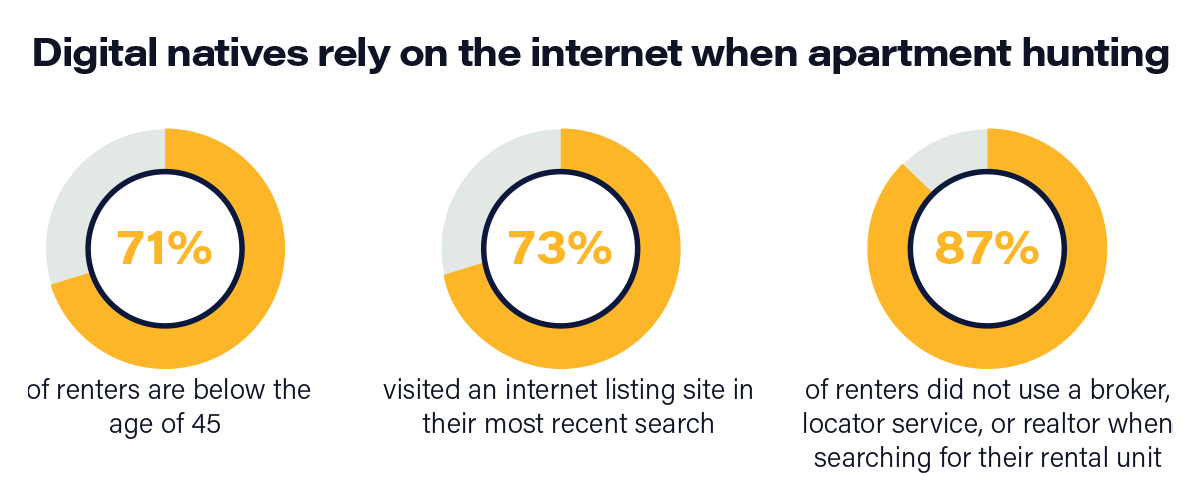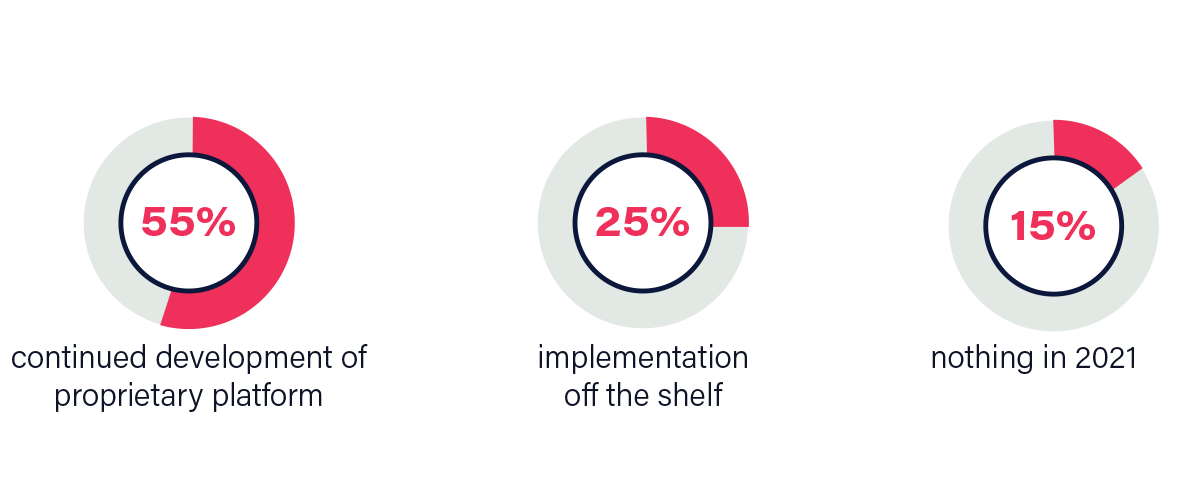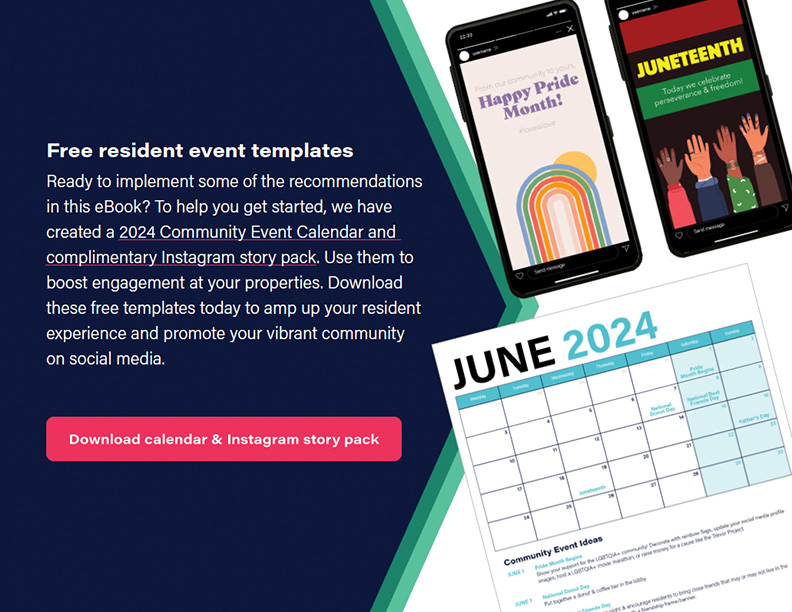Property management marketing trends & predictions for the future
Dig into three major trends impacting the multifamily marketing landscape, and learn what predictions experts have for the future of property management marketing.
What are the top trends impacting property management marketing?
Property management marketing trends have evolved dramatically over the past few decades. An apartment search pre-internet consisted of driving around desired neighborhoods looking for vacancy signage, asking a friend for a referral, or searching the local paper’s classifieds.
Jumping forward to a few years ago, the market was dominated by Internet Listing Services (ILS). Not long after ILS syndication, there was a mass consolidation. Companies like Apartments.com and CoStar bought a lot of the regional ILS companies.
Multifamily marketers began to invest in their own websites. And as time went on, their investment paid off. Individual management sites started to reclaim the first page of Google.
Now that most multifamily properties have the digital foundation of a website and a CRM tool, companies are looking at a more holistic approach to property marketing. They are realizing that prospective residents want control over their entire leasing experience.
“When [prospective renters] show up on site, their decision is already pretty close to made. It’s now about validating the relationship that they formed with the leasing associate, and making sure that there is cohesion between what they saw online and what they’re seeing in real life.” – Michael Manfred, VP of Field Marketing, The NRP Group
3 Standout property management marketing trends
- The growing adoption of digital communication channels
- The heightened importance of online resident reviews
- The proven return on delivering exceptional community living experiences
Property Management Marketing Trend #1: The growing importance of digital communication channels
According to the 2022 NMHC Renter Preferences Report, 71% of renters are below the age of 45. These Millennial and Gen Z renters are digital pioneers and natives. For most of their lives, the internet, social media, smart phones, online shopping, etc have been ubiquitous. It is no surprise that they expect their apartment communities’ digital platforms to provide a seamless, intuitive experience as well.
NMHC also reported that 87% of renters surveyed in 2022 did not use a broker, locator service, or realtor when searching for their rental unit. Today’s prospective renters are turning to the internet first, conducting their own apartment research online. In fact, 73% of those surveyed said they visited an ILS, such as Apartments.com or Rent.com in their most recent search.
“Prospective renters expect a highly personalized, seamless experience when they interact with your brand—across every channel and at every stage of the customer journey.” – WPROMOTE
What the digital-first property management marketing trend means for property marketers
Across industries, brands are delivering a digital-first experience to meet consumer expectations, and multifamily is no exception. Communities need to meet renters where they are – TikTok, Instagram, ILSs, Google, etc.

Property Management Marketing Trend #2: Word-of-mouth & resident recommendations are essential
Survey data from Zego’s 2022 State of Resident Experience Management Report found that the majority of property management companies consider their online reputation to be ‘Extremely important’ in their acquisition efforts. But in order to create a positive online reputation that drives leads, property marketers are placing an equal focus on the resident experience to boost community advocacy amongst their current renters.
“When we ‘talk marketing’ in our company, we talk about marketing that drives leases, leads, traffic, all of that. Then we talk about marketing that retains all of that hard earned work. So to me, they’re peanut butter and jelly.” – Barbara Savona, CEO & Founder of Sprout Marketing Multifamily
Ultimately, a property marketer’s goal is to help increase exposure for the asset or unit, attract quality leads, and fill vacancies. However, Zumper’s Annual Rent Report found that 82% of renters plan to move in the next year. If no marketing efforts are focused on retention, those companies will assume greater financial risks as the market cools.
What a focus on referrals & reviews means for property management marketers
Referrals and positive reviews stem from the holistic sense of belonging your residents feel from marketing to move-out. Residents are excited to spread the word when their community is warm, welcoming and exceeds expectations.
Cold, corporate communication and a fend-for-yourself approach won’t cut it with today’s renters. “Our resident experience does not, in our view, start at the move-in process. It starts at the very beginning of the leasing funnel. From your marketing platforms, to your first point of contact, to follow-up, to the first time that they come into the building,” said Jered Lerum, Director of Business Development for Edison47.
Leverage resident communications, community events, contests, technology, partnerships, customer service, and more to create a resident experience that commands attention and draws prospective renters in.
“By infusing the community with a sense of home, residents will receive the living experience they’re looking for and have higher long-term satisfaction with their community. – Parcel Pending
Property Management Marketing Trend #3: With higher rents come higher expectations
Due to increased demand, higher rents, and elevated expectations, multifamily marketers have been looking to the hotel, restaurant, and other service industries for inspiration. “We can learn lessons from everything they’re doing from design to services to technology and even how they brand,” said Jamie Gorski, CMO of Bozzuto.
In an article for GlobeSt, Gidi Cohen, founder and CEO of CGI Strategies said hospitality-focused assets like lobby bars, food delivery providers, and dry cleaning services command higher occupancy and rental rates for multifamily communities. “Developers who understand this shift in real estate consumer psychology are adding hospitality features into their development plans from day one.”
“Right now apartments are selling themselves. But as things start to tighten up, and the market starts to shift, those that will be easier to rent are going to be those with extra amenities,” said Scott Hines, VP of Technology and Revenue at PEM Real Estate Group, when we asked him about property management marketing trends. “We’re even seeing more amenity-driven services. We just looked at one where the whole product is about connecting cleaners with the residents,” Scott continued. The community can enjoy a hands-off approach while still providing an avenue for residents to easily access valuable services. “[Properties] are using tech to their advantage to create these accessible amenities.”
Why hospitality trends matter in multifamily
The number one lesson multifamily companies can learn from the hospitality industry is the importance of customer service. “It’s all about service,” says Joe Melton, VP of Marketing and Management Support Services for The Morgan Group. “Your brand is how you treat people, it’s everything in your organization that does not expire.” One of the best property management marketing trends is to engage and retain your community by prioritizing digital and physical amenities, while amping up your customer support.
“We get so stuck on the gimmicks, the gifts and it’s really, usually none of that. It’s all the little tiny things in between. It’s delivering on promises. And at the core, that’s what I think the resident experience is. It’s the feeling they get from every interaction with you throughout their journey.” – Barbara Savona, CEO & Founder of Sprout Marketing Multifamily
Looking ahead: the future of property management
These property management marketing trends are having a major impact on the multifamily industry today. But what can we expect to make a splash down the road? Let’s examine some of the top predictions from expert multifamily marketers.
Virtual tours within the Metaverse
The metaverse is a digital world created using augmented/virtual reality that users can access with a VR headset, such as Oculus. As the Metaverse continues to evolve, industries will begin to leverage its scale and capabilities. They may host conferences, virtual vacations, and entertainment events such as live concerts and sports games.
In 2021, venture capital firms invested over $3.9 billion into metaverse startups, and real estate sales in the metaverse topped $500 million. “Luxury residential brokers are starting to utilize the metaverse to create new sale channels and make property tours more conversational, so can the multifamily industry.”
Virtual tours have continued to gain momentum even past the pandemic. So, it makes sense that the Metaverse is next on the horizon for the future of property management. “In the long run – we will slowly see tours connect into the Metaverse, where people can virtually walk through an apartment from anywhere in the world,” said Kerry W. Kirby, CEO of 365 Connect.
Resident Benefit Packages
More and more property management companies are starting to create a robust and competitive benefits package that attracts new renters and improves resident satisfaction. A resident benefits package lets you shine a spotlight on the perks of living in your community and makes it easier for your staff to deliver the ultimate resident experience.
Unique benefits for residents can help differentiate your community from the competition. Significant selling points for a robust benefits package include:
A Modern Resident App
- Incoming residents enjoy a mobile onboarding experience with access to key features like their move-in checklist, and freight elevator reservations.
- Current residents can get package notifications, submit and track the status of work orders, create virtual bulletin board posts and more all through their app.
- Communicate with residents via their preferred method, improving satisfaction and engagement.
Easy Access to Special Perks
- Let residents enjoy special offers and discounts on national and local services through a Marketplace feature.
- Residents can reserve amenities like the clubhouse and gym equipment through their community app.
- Residents can view details on and RSVP to their community’s live and virtual events, increasing engagement with your community.
Comprehensive Payment Choices
- Residents enjoy multiple payment options – including bank account, credit/debit card, cash, and check – which are all converted to digital payments to reduce your staff workload.
- Offer Flexible Rent Payments, so that you get paid in-full and on-time, while your residents gain the flexibility to pay rent in installments that work best with their budget.
Financial Planning and Incentives
- Offer rental credit reporting to reward on-time payments by enabling residents to build credit with their rent payments.
- Give residents convenience of variable AutoPay, so they never have to worry about late fees, even if the amount they owe changes each month.
Betting on Business Intelligence
Business Intelligence (BI) software provides multifamily owners and operators with a centralized tool for reporting, analysis, monitoring, and predictions. A good BI tool will use your portfolio data and market data to help you identify risks and opportunities. The 2022 edition of 20for20 found that most management companies have either purchased an “off-the-shelf” BI platform, or have invested in their own proprietary platform.

The report noted that while BI has been around for a long time, the industry has been slow to adopt this technology. Especially compared to newer solutions. But, the COVID-19 pandemic forced many multifamily professionals to shelter in place. This created the need for a centralized data platform for the future of property management. Now, in 2022, COOs rated BI as their highest technology priority. “Some forward-thinking operators are trying to understand how their BI can leverage and support new capabilities, like IoT technology, leasing tech and centralization.”
“Vacation Club” housing memberships
The popularity of short-term vacation rentals, along with the fact that 27% of renters work from home full-time, have increased the demand for lease term flexibility. This is especially true for younger renters without kids who want to explore different cities.
46% of residents are not in favor of living in a community where units are rented out to strangers on a short-term basis. So, “Vacation club” housing memberships could be a great alternative, since the residents are pre-vetted.
This type of program does not exist yet, but apartment owners with larger portfolios are thinking about it as a way to retain short-term residents. This would allow the resident to explore different properties within the portfolio. Which would help operators easily fill vacancies with pre-qualified, trustworthy residents.
NMHC reported that 46% of respondents said they would consider joining a rental housing membership program that would allow its members the flexibility to move between communities within a brand’s network of properties.

The future of property management means going back to basics
Genuine human interaction has become less of a focus in this increasingly digital world. But in terms of resident acquisition, excellent written and verbal skills can help your communications stand out in the marketplace. In an interview for Zego’s Resident Experience Podcast, Barbara Savona, CEO & Founder at Sprout Marketing Multifamily, said “you can be scrolling TikTok for an hour and you walk away with this dazed feeling of like, what did I just watch for an hour? And then you can have a really meaningful interaction with someone that can leave you smiling for the rest of the day.”
According to Gartner’s 2022 trends, consumers want simple, straightforward communication from the brands they interact with. While automation can help streamline the leasing process, the human element cannot be replicated by a machine. The future of property management will likely include an increased focus on training leasing teams to be better conversationalists. They will need to know how to respond eloquently and efficiently to incoming leads.
The guide to creating a modern apartment digital marketing plan
Want to dive deeper into how these property management marketing trends can impact your multifamily marketing plan? Experts revealed how to deliver an exceptional experience across the prospect-to-resident journey that boosts acquisition and retention in our free digital guide, Multifamily Property Marketing for the Resident Experience Revolution.


FREE GUIDE
Multifamily Property Marketing for the Resident Experience Revolution
Explore property marketing trends impacting the industry, and learn how to create a multifamily marketing plan for the prospect-to-resident experience.